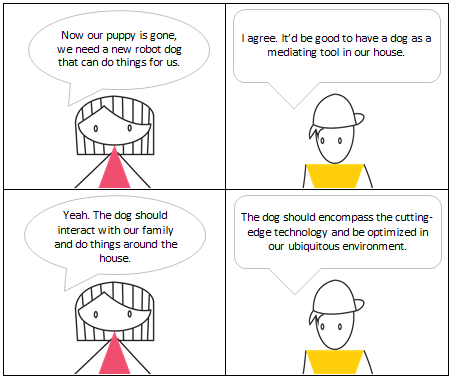“We need a robot dog as an interaction instrument so it helps our family (subject) interact with things around our house (object).” – Son & Daughter
Description and History
What is Activity Theory?
Activity Theory is a psychological and other social science approach that frames human beings and their social entities in conjunction with environment, history, culture, personality, motivation, etc. Activity Theory places its premises on individual human and their intentionality, which is described as human agency.
Activity Theory also understands that human activity and activity of any subject are achieved by the purposeful interaction between subject (human being) and object (physical products, knowledge, or experience), mediated by artifacts (tools, documents, recipes, etc.).
History
Activity Theory has its root in Lev Semyonovich Vygotsky’s cultural historical psychology from the 1920s. Then activity theory was introduced by Leontiev in the 1930s. Then in the 1970s and 80s, it also influenced the development of German work psychology.
Then the first attempt to introduce activity theory as a theoretical foundation for HCI was brought by Susanne Bodker, a Danish computer scientist in the early 1980s. In the early 1990s, activity theory became known to international research communities in human-computer interaction, computer-supported cooperative work, and information systems relatively recently as many books and seminal papers in the field started getting influenced by activity theory.
Activity Theory in HCI
The rise of the personal computer conveyed many challenges in traditional system developments and work routines, which eventually brought forth a need to focus on how to work on materials and objects through the computer. So the development of the activity theoretical angle was primarily carried out by Bødker and Kuutti. The work of Kaptelinin has been important to connect to the earlier development of activity theory in Russia. Nardi produced the most applicable collection of activity theoretical HCI literature.
Reformation of HCI Concepts
The underlying principles of activity theory have reshaped some core concepts of traditional HCI, including concepts of transparency, affordance, and direct manipulation. Then, these principles are exemplified as “instrument” and “domain object” in interaction design where interaction instruments are user interface components that transform user actions into commands for domain objects and domain objects are potential objects of interest for users (Kaptelinin and Nardi 83).
Limitations of Activity Theory
Activity Theory comes from longer tradition and has greater thoughts than other relatively new theories in the field (e.g. Distributed Cognition). So Activity Theory has set its foot in many areas such as cognition, ethnomethodology, psychology, education, organizational studies, policy studies, etc. Therefore, the scope of activity theory can be ambiguous compare to those of other theories in the field.
Also, time is very hard to handle in Activity Theory. In triangular Activity System produced by Engestrom, time is not considered within one triangular model. Chains of triangles may be used to show development of time, but it is still very hard to capture time in Activity Theory.
Friends of Activity Theory
Bonnie Nardi
 Bonnie Nardi is a professor in the Department of Informatics in the Donald Bren School of Information and Computer Sciences at the University of California, Irvine. Her interests are in HCI, CSCW, more specifically in activity theory, computer-mediated communication, and interaction design.
Bonnie Nardi is a professor in the Department of Informatics in the Donald Bren School of Information and Computer Sciences at the University of California, Irvine. Her interests are in HCI, CSCW, more specifically in activity theory, computer-mediated communication, and interaction design.
She is one of more recent activity theory researchers along with Kaptelinin, who she had produced several publications together. Her major publications on activity theory include Acting with Technology: Activity Theory and Interaction Design (2006) and Context and Consciousness: Activity Theory and Human-Computer Interaction (1996).
The following is the quote from her website on how she defines activity theory.
“Activity theory proposes that consciousness is shaped by practice, that people and artifacts mediate our relationship with reality. Consciousness is produced in the enactment of activity with other people and things, rather than being something confined inside a human head. Activity theory works well with design because activity theorists have always tested their theories in practical ways and believe that application is an outcome of theory, not a separate activity. In some of my writings I have discussed how, as a psychological theory, activity theory can be scaled to collaborative settings without losing sight of individual participants in an activity.” (http://www.artifex.org/~bonnie/)
Applications of Activity Theory
In an attempt to find application that represents some of the core concepts in activity theory in the house environment (just like our robot dog), we focused on the subject-object relationship that is accomplished by its mediating instrument. Then, we found the Nest Learning Thermostat. The Nest Learning Thermostat is a thermostat that memorizes users’ patterns and sets temperature automatically according to their habits. It also provides the mobile phone app so the users can control the thermostat even when they are not home.
From the book, Acting with Technology, written by Kaptelinin and Nardi, they have written, “the aim of design should be to provide an optimal integration of domain objects and interaction instruments, rather than to make interaction as direct as possible (Kaptelinin and Nardi 83).”
We thought the Nest Learning Thermostat represents this argument very well. The design of this small thermostat, the interaction instrument, becomes optimally integrated in the house, the domain object, helping the interaction between subject (human) and object (house) less perceptible. Watch the video in the following link to find out about more great features offered by this thermostat. http://www.nest.com/living-with-nest/#videotour
Links for Further Study
Activity Theory and the Practice of Design. http://www.ics.uci.edu/~redmiles/activity/final-issue/Clases/Clases.pdf
Activity Theory and Human-Computer Interaction by Bonnie Nardi. http://www.ics.uci.edu/~corps/phaseii/nardi-ch1.pdf
http://en.wikipedia.org/wiki/Activity_theory
http://www.learning-theories.com/activity-theory.html






Leave a comment